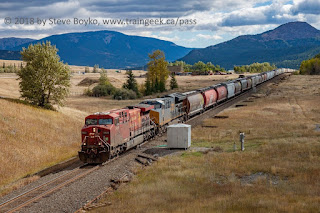My friend Steve Boyko—owner of the long-running Traingeek.ca blog—has a new book out.
With 143
pages and over 200 photos, the book takes readers on a trip through those two
provinces, including visits to the Canadian Museum of Rail Travel, the
Revelstoke Railway Museum and the Three Valley Gap rail museum.
I’m
always impressed when someone writes and publishes a book, so I sent Steve some
questions. Plus, he interviewed me back in 2015—now it was my turn to interview him!
Why did
you write the book?
I originally shared the
story as a series of blog posts. I thought some people might prefer to read it as
a single, longer story, and I also felt I might reach a different and wider
audience if I put it on Amazon. The jury is still out on that!
In a larger sense, I
wrote the original blog series because I like to tell stories and share my
photography.
Why
Alberta and B.C.?
There were a few reasons
why I chose Alberta and British Columbia. My wife and I both love the Banff-
Lake Louise area and the Rockies in general. I love photographing trains in the
mountains. I had never been through the Crowsnest Pass.
The most important driver,
though, was to visit the Museum of Rail Travel in Cranbrook, BC. My father
visited that years ago and recommended it to me. I had always intended to go,
and this was my chance.
Did
anything surprise or jump out at you from the visit?
The most surprising
thing, to me, is how well the trip went. Except for the wildfires spoiling our
chance to visit Waterton Park, everything went pretty much according to plan.
I was surprised at how
much CP traffic there was between Cranbrook and Golden. I hadn’t expected much.
Given how little CP traffic there is around Winnipeg, I am often surprised by
the traffic that goes between Vancouver and Calgary.
What was
your favourite railfan spot?
The Crowsnest Pass. There
are a lot of great locations with a lot of variety. My favourite photograph of
the whole trip was made at Sentinel.
I assume
you visited some locations for the second or more times. What changes did you
see?
I’ve been on the section
between Calgary and Pincher Creek before. I didn’t see any changes there, but I
went out of my way to photograph three grain elevators I hadn’t seen before (De
Winton, Azure, and Raley).
I’ve also been on the
section between Field, B.C. and Calgary several times. One change was that I
couldn’t visit Morant’s Curve this time, because the highway next to it was
being rebuilt. I understand it is much better and safer now. Unfortunately,
Parks Canada didn’t chop down any trees, so the view is still not as good as
years past.
The Spiral Tunnels were
more overgrown than I remembered from my previous visits, too.
What do
you hope the reader comes away with from the book?
I hope readers gain an
appreciation for how beautiful Alberta and British Columbia are, especially the
mountainous areas. I never get tired of visiting there.
How did
you become interested in trains in the first place?
I visited the Salem and
Hillsborough Railroad in New Brunswick in 1998. That really provided the spark
that ignited my interest in trains that has become an obsession. I think it was
something that had laid dormant in me for a long time and just needed a little
push to come to the surface.
Over time I’ve become
“better” at railfanning—finding trains and better locations to photograph them
in – but the interest hasn’t faded.
Any
general observations from a half-century (or thereabouts) from chasing trains?
You can spend a lifetime
observing and chasing trains and never learn everything about trains and the
people that run them. There is so much variety in the locomotives, the cars,
the track, the signals, the roadbed, the people, the railway companies. It’s a
vast hobby with room for everyone of all interests.
Also, trains are cool.
Anything else to add?
Stay safe out there. I
love making photographs, but a great picture is not worth risking your life
for.
Also, it feels a little
weird to be answering the questions instead of asking them! Thanks for the
opportunity.













